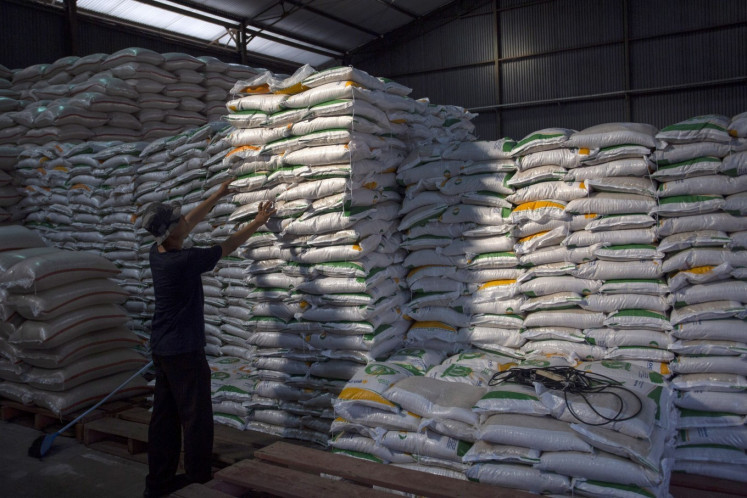Popular Reads
Top Results
Can't find what you're looking for?
View all search resultsPopular Reads
Top Results
Can't find what you're looking for?
View all search resultsBali's ancient history at 10 cents a brick
Oops : A 2,000-year-old sarcophagus broken
Change text size
Gift Premium Articles
to Anyone
Oops : A 2,000-year-old sarcophagus broken. (JP/J.B. Djwan)
A second stone sarcophagus was found Saturday just 7 meters from an earlier sarcophagus discovered less than three weeks ago at a Keramas brickmaking site.
This second sarcophagus has led some archeologists to suggest the site may once have been the burial ground of ancient chieftains. A human skull and leg bones were also discovered, and may form part of a chieftain's burial retinue.
The small egg-shaped sarcophagus found Saturday by brickmaker Muksin Riadi may be the coffin of a child. The stone coffin is believed to be between 2,000 and 2,500 years old.
Ironically, the head of the Bali Archeology Agency, Wayan Suantika, says this latest find increases his agency's belief that the Keramas site is of low archeological significance.
"The site at this stage is not considered of high significance. We have only uncovered two sarcophagi to date and there is little material, such as prehistoric pottery and ceramics, when compared to sites such as Gilimanuk. There we see meter-thick strata of pottery," Suantika says.
The two sarcophagi were unearthed by brickmakers within 20 days of each other.
Suantika adds there is at this stage little evidence of long-term habitation at the site, known in ancient times as Abang, according to local villagers.
"People may have settled here for only a short time and then moved on," Suantika says.
However, without funded research, how long the area was used by ancient peoples remains unknown.
The ground is littered with prehistoric pottery, 11th-century Song Dynasty ceramic shards and later shards from the Ming Dynasty.
Some archeologists suggest these shards represent more than 35 centuries of human activity.
The pottery and ceramics are unearthed daily by brickmakers at Keramas, broken by hoes used to carve out clay. Song Dynasty bowls sell today for between US$5,000 and $10,000. Bricks sell for 10 cents.
Hundreds of simple stone sarcophagi have been unearthed across Bali, and only a handful bear intricate carvings - it is the sheer volume of unadorned sarcophagi that render them of low significance.
Wasted: Bali’s ancient history is being cast into bricks at this Keramas brick-making site where two stone sarcophagi have been unearthed just meters apart in less than three weeks. (JP/J.B. Djwan)
That viewpoint and lack of funding may be to blame for the shattering of the earlier sarcophagus at the Keramas site, which, while slightly damaged on discovery, was all but destroyed during removal and transportation.
Transporters attempted to open the sarcophagus with an iron crowbar, causing the sarcophagus to shatter into several pieces. Due to the workers' lack of archeological knowledge, the site was not examined for bones or other artifacts that may have given a clue as to how the ancient ruler lived and died. A skull and leg bones were unearthed a few days later by a brickmaker and set aside in a bucket for safety.
Substantially more care was taken the second time around, with archeologists from a conservation team excavating the new sarcophagus site almost grain by grain to safely extract the intact coffin.
Ngurah, from the Bali Conservation Museum, explains that the earlier sarcophagus was removed by local people without training in handling priceless artifacts. He blames a shortage of funding for the way the earlier sarcophagus had been removed to the conservation museum.
"The first sarcophagus was removed by local people. Now we have taken over the site to safely remove this second sarcophagus," he says.
The Bali Antiquities Museum, headed by I Made Suantra, has more than 200 staff across Bali and the East Nusa Tenggara.
Udayana University archeologist Agung Rochtri disagrees with Suantika's take on the significance of the Keramas site, pointing to the volume of pottery and ceramics potentially dating across more than 3500 years.
"I feel the pottery and ceramics are good evidence of long-term human habitation at this site. From the quantity and quality of pottery here, I believe this is a quality archeological site. There is a greater volume of pottery and ceramics at the Gilimanuk site; however, that site has fewer sarcophagi than here," Rochtri says.
"I certainly believe the site should be protected and research undertaken. From the placement of this graveyard on high ground I believe this was an important burial site. Heads of villages were buried on high ground so this gives us an indication of their role."
He adds it is most likely the sarcophagi were buried at the Keramas site.
Other archeologists have suggested the sarcophagi may have been washed to the site during landslides, further adding to the site's low-significance status.
"Looking at the terrain here, I feel this is the original burial site," Rochtri says.
Discussing the discovery of the skull and bones, Rochtri is adamant.
"This is not right. Everything found on the site needs to be documented and protected," he says, stressing the urgent need for the Keramas site to be secured for archeological investigation.
However, Rochtri's hands are tied through a lack of funding, as are those of the Bali Archeology Agency.
"Udayana University has no government funding for research. If funding comes up, it will be too late," he says.
Without research, no one will ever know how old these sarcophagi are, how large the ancient village was and for how many centuries people lived and worked in this area. This knowledge will instead be baked into bricks sold at 10 cents apiece.











